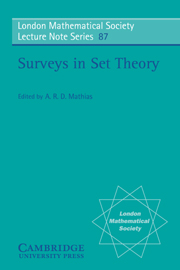Book contents
- Frontmatter
- Contents
- PREFACE
- ITERATED FORCING
- THE YORKSHIREMAN'S GUIDE TO PROPER FORCING
- THE SINGULAR CARDINALS PROBLEM; INDEPENDENCE RESULTS
- TREES, NORMS AND SCALES
- ON THE REGULARITY OF ULTRAFILTERS
- MORASSES IN COMBINATORIAL SET THEORY
- A SHORT COURSE ON GAP-ONE MORASSES WITH A REVIEW OF THE FINE STRUCTURE OF L
- LIST OF PARTICIPANTS
MORASSES IN COMBINATORIAL SET THEORY
Published online by Cambridge University Press: 04 August 2010
- Frontmatter
- Contents
- PREFACE
- ITERATED FORCING
- THE YORKSHIREMAN'S GUIDE TO PROPER FORCING
- THE SINGULAR CARDINALS PROBLEM; INDEPENDENCE RESULTS
- TREES, NORMS AND SCALES
- ON THE REGULARITY OF ULTRAFILTERS
- MORASSES IN COMBINATORIAL SET THEORY
- A SHORT COURSE ON GAP-ONE MORASSES WITH A REVIEW OF THE FINE STRUCTURE OF L
- LIST OF PARTICIPANTS
Summary
Jensen invented the morass in order to establish strong model-theoretic transfer principles in the constructible universe. Morasses are structures of considerable complexity, a culminating edifice in Jensen's remarkable program of formulating useful combinatorial principles which obtain in the constructible universe, and which moreover can be appended to any model of set theory by straightforward forcing. Gődel's Axiom of Constructibility V = L is surely the ultimate combinatorial principle in ZFC, and the morass codifies a substantial portion of the structure of L. As set theorists looked beyond the well-known ◊ and □ for applicable combinatorial principles, it was natural to consider extractions from the full structure of a morass.
This paper is an expository survey that schematizes the higher combinatorial principles derivable from morasses which have emerged in set theoretical praxis. It is notable that most of these principles were formulated by combinatorial set theorists to isolate salient features of particular constructions, and shown by them to be consistent first by forcing. Then, the specialists in L established how they hold there, in ad hoc fashion using the full structure of the morass. The sections of this paper deal successively with Prikry's Principle, Silver's Principle, Burgess' Principle, and finally limit cardinal versions. This sequence reflects the historical development of ideas, the progression toward further complexity, and coincidentally the author's series of papers.
- Type
- Chapter
- Information
- Surveys in Set Theory , pp. 167 - 196Publisher: Cambridge University PressPrint publication year: 1983
- 6
- Cited by



